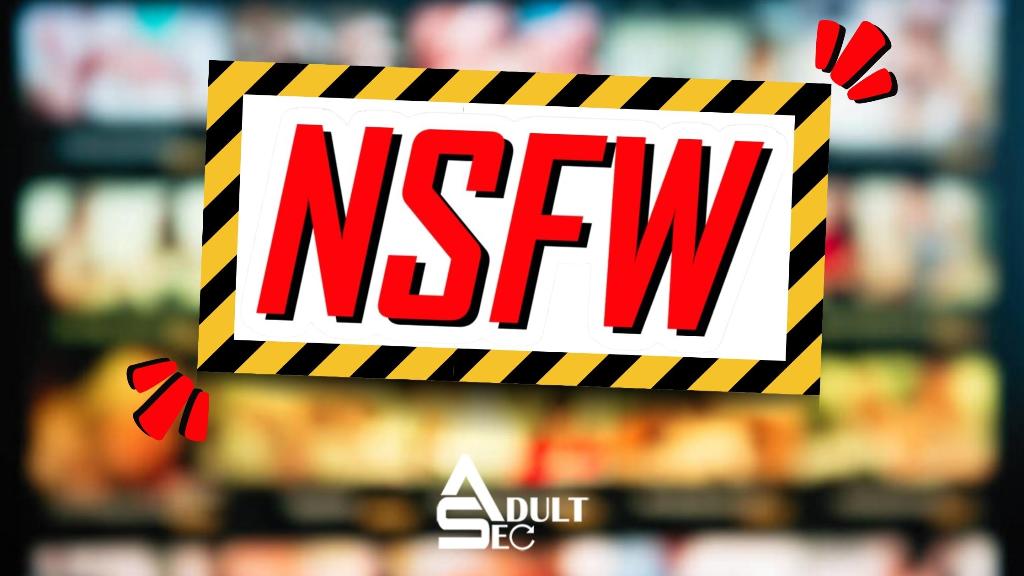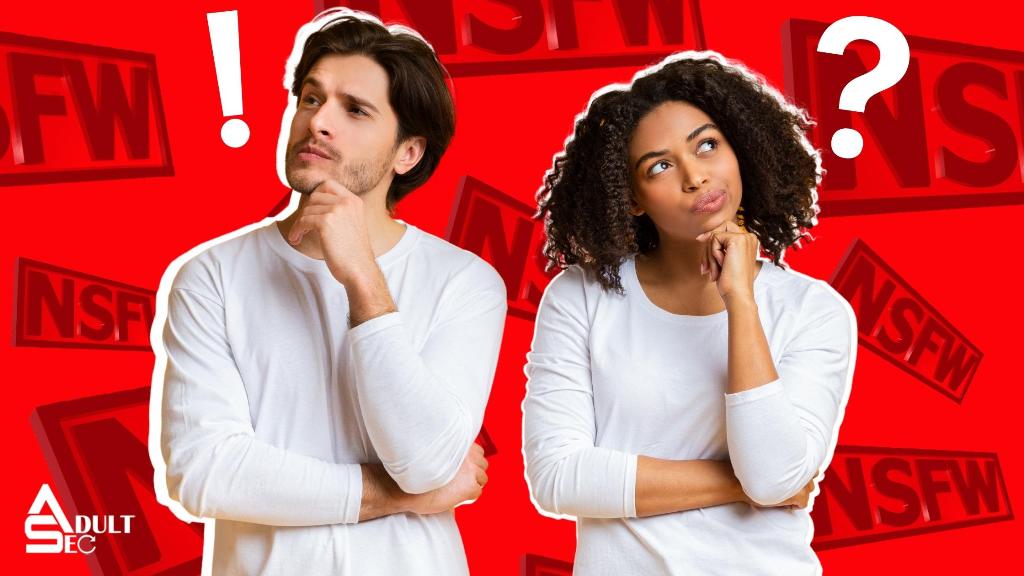
What is an NSFW warning, and when should you use it?
NSFW stands for “not safe for work.” You’ve probably seen it as a disclaimer on images and audio clips. Acronyms are used when the item has the potential to cause someone to be dismissed from their job because of pornographic, violent, or otherwise improper content.
That’s what it meant in its original context, at least. NSFW is becoming a catch-all term for anything that can make a viewer uncomfortable. Turn your screen off and check it out for yourself before sharing it with anybody else.
What exactly does NSFW stand for?
“Not safe for work” is the explanation of NSFW. A frequent online content warning is the abbreviation, “material not suitable for viewing while at work or in public.”
It would help if you stopped observing at this gratified at work or in the attendance of others unless you are willing to risk a chat with the HR department.
The NSFW tag was initially intended to warn viewers about explicit sexual content. Still, it has expanded to include a wider variety of sensitive and possibly upsetting material.
The NSFW label is routinely applied to any adult website or picture that could raise some eyebrows, even if the context is benign, so be extra cautious. On Reddit, for instance, a photograph of a filthy urinal might be marked with the NSFW tag.
The NSFW tag is often used on Reddit, a general social media stage. NSFW maybe used casually, such as at the top of a Post on Facebook or officially on a Discord server or channel declared as NSFW to everyone on the server or track.
The etymology of NSFW For Any Adult Webpage
It used to be pretty simple to stay away from offensive material. There were R-rated movies, explicit periodicals, and a caution to get youngsters out of the room before the start of The Maury Show.
As a result of the net propagation, anybody may crop material. People seldom designate their photographs, videos, or websites as unsuitable, which is expected. When it comes to “inappropriate” information, individuals tend to publish it in forums where the content is already accepted properly, like on adult sites.
According to this perspective, NSFW looks like “This program includes scenes that may be offensive to some viewers.” Even though that’s the way it’s often used now, the term was coined in response to a very particular issue.
What Is the Process for Making an NSFW Filter?

If you wish to obscure NSFW information on your adult website, there are many methods to do it. The PixLab API and Computer Vision are used in the first technique, which is fully automated. Using a PixLab API Key, photos may be examined to see whether they are NSFW or not. The PixLAB API must be implemented to take advantage of this technique.
A grade will be assigned to the photo. The more NSFW a picture is, the closer it gets to “1.” This is all done in the background, but you will need to know how to code in the language of your adult website before you can add the code yourself.
You may also link directly to the picture. A more time-consuming method is to alert the reader that the image is sexually explicit before providing a link. If they click on the link, give them fair notice.
Using imagga, Microsoft’s Azure Content Moderator, or similar automated systems provide a third approach. For those that don’t have an in-house moderating staff, technologies like these may assist in streamlining the day-to-day maintenance of an adult website or forum.
In addition, you have various choices. Facebook accounts may be linked to user postings. If they have fewer than 50 friends, for example, limit their ability to publish photographs until a person can approve them. As an option, you may also give a “Report” button for people to self-report NSFW photos that they come across.
A Guide to the Professional Use of NSFW For Adult Website

Despite what you may believe, it is not true that NSFW is used for lighthearted purposes. NSFW content may be found in public service announcements, medical advice, and business-related films. Here’s an example of correctly using the NSFW flag in your work.
Messages for the Common Good
Naughty-but-not-nice (NSFW) is a frequent designation for public service announcements that display graphic images of violent crime or traffic accidents. Official traffic police social media sites have done this in the past to increase public awareness about the dangers of reckless driving by posting images of actual incidents caused by careless drivers.
As a result of smoking depictions or individuals who have had medical procedures due to smoking-related cancer or other sicknesses, anti-smoking campaigns may also include an NSFW warning.
Educative Material
An NSFW warning could be required for many educational films. For example, movies or photographs depicting natural catastrophes, conflicts, or historical events with horrific images of human suffering are examples of this content. Similarly, movies promoting animal rights may have to be labeled NSFW due to animal brutality’s graphic depictions.
Advertisement
To warn viewers that the information they are going to see could be upsetting to some people, several businesses utilize NSFW in their advertisements. NSFW warnings may be required for content that depicts extreme sports or other images that may be distressing to some viewers.
Discussions in a Group or a Classroom
Discussions on addiction, abuse, exploitation, and violence may be covered under the NSFW umbrella by many non-profits, government agencies, and neighborhood associations.
How to Designate NSFW Material?

It is possible to label your work as NSFW in various ways. Listed below are a few professional examples.
Social Media
It is possible to label information on social media platforms like Facebook and YouTube based on the user’s age. For this rule, anything from Facebook pages to movies that have been posted is considered. Selecting the content rating gives you access to the age filter. Adult, 18+, or R-rated content would be considered NSFW.
Website
Pages, movies, and photographs that can be considered NSFW might be labeled as such. When a user is presented with a warning, they may be required to click on a link to confirm that they are above the age of 18 or agrees to the terms and conditions. This may also assist firms in avoiding legal concerns since it may not be permitted in certain countries to broadcast such information without user permission or a warning. When children are in danger of seeing distressing material, this is particularly important.
During Professional Correspondence
You’ll likely need to send information that requires an NSFW notice in professional contacts, such as an email. For example, to convey to your patient the dangers of undergoing surgery, you may be required to offer a video or images and photographs that others may consider distressing.
NSFW (not safe for work) mode may be enabled on your account
You will get a warning while reading 500px’s Not Safe For Work content. Go to the Settings and select the Display Not Safe for Work-NSFW Content option at the bottom right of the panel, then tick Save.
Mobile Apps Contain ‘NSFW’ (Not Safe for Work) Content
We screen NSFW content from our iOS and Android applications to ensure that they are open to everyone and that our photographers and their work remain at the center of our inclusive community. However, the content will not be accessible through our mobile apps. A desktop connection is still required to access the material.
In other words, NSFW material will not be accessible through search, and it will not appear on your Home Feed. This is because of the policies established by Apple and Google. To make the 500px mobile experience available to as many people as possible, we must abide by its guidelines.
Content Restraint for NSFW (Not Safe for Work)
Photo moderators keep an eye on the adult site. In addition, we have an entirely automated moderation system. Suppose a member of the 500px community reports a picture for being incorrectly labeled as NSFW Content. In that case, a mediator will look at the photograph to choose whether it is NSFW content.
Contaminated Material
On 500px, we do not accept images depicting sexual organs or sexual activities. Vagina, penis, and anuses may all be shown in this way. In addition, photographs depicting explicit sexual behaviors (such as intimate encounters, masturbation, oral sex, etc.) are not permitted.
Based on the image and context, any photographs that include kid nudity may be reported to the authorities and the International Women’s Football Federation (IWF).
Uploaded content that includes excessive violence, animal cruelty, or other criminal conduct is likewise forbidden.
Imagery depicting cultural appropriation (such as non-Native American or Indigenous peoples’ emblems worn by Caucasian models) might be deemed offensive, depending on the photograph’s context.
After being warned once, you’ll be banned if you continue to post this material on your 500px account. 500px moderators have the last say on whether or not material is filtered or removed from the adult site. Following our Terms of Service, our moderators have the authority to filter and delete material at any moment without providing a comprehensive reason.
How do you agree with the subject of NSFW material For the Adult Webpage?

There are human and technical aspects to consider when reducing the danger of improper picture and video sharing.
Staff should be cultured and made aware of their obligations to create a work situation that is courteous to their coworkers and lawful. In addition, employee handbooks should explicitly state and enforce any regulations against unauthorized sharing at the workplace.
Image and video content analysis should be integrated into the primary platforms used by workers to access and share company information from a technological aspect. Email content and attachments should be scanned using a modern email security solution for indecent or hazardous images, videos, and other media files.
For example, by integrating image content analysis technologies, online filtering rules might be set up to monitor and block the browser from accessing pornographic, offensive, or extremist material.
The new cloud-first environment, particularly after COVID, also implies combining image and video analysis with a CASB to secure the whole spectrum of cloud services. Scanning all data sent to cloud storage services like Dropbox, OneDrive, and Google Drive will be possible.
Using deep learning technology, image content analysis tools can identify and eliminate false positives. It is possible to deploy an Acceptable Use Policy at scale, without manual moderation, while maintaining a complete audit trail when implemented across various channels and intelligently updated by machine learning (ML).
NSFW photos may be discovered and regulated before disseminating them on internal systems by safeguarding video and image transmission technologies. Tactically this supports good culture and identifies people who misuse business channels. It decreases the company’s reputational risk and the likelihood of a lawsuit.
Stopping the user from doing the action is the most excellent defense in any human danger situation. On the other hand, people might be unpredictable and untrustworthy in a security setting. Automation is essential to ensuring that the problem is dealt with at a large scale and repeatable way.
Final Words
Non-work-related information may be sent from an official email address to friends and colleagues and accessed from a personal email account while at work. Employees might get into problems posting inappropriate or racist humor, sexually explicit material, or excessively personal stuff.
Sexually explicit or unpleasant information is strictly forbidden in several workplaces or even on social media. For folks who don’t know what they’re looking at, NSFW is a warning that the material might get them in hot water if their boss or supervisor finds them. Such materials are seen as a waste of business resources. In nations with a high litigation rate, such as the United States, senior management may be concerned that workers who have received such materials would sue the firm for sexual harassment.
It’s up to the viewer to decide what constitutes NSFW material for any adult website. However, there are clear limits concerning what is and isn’t suitable in the office.

